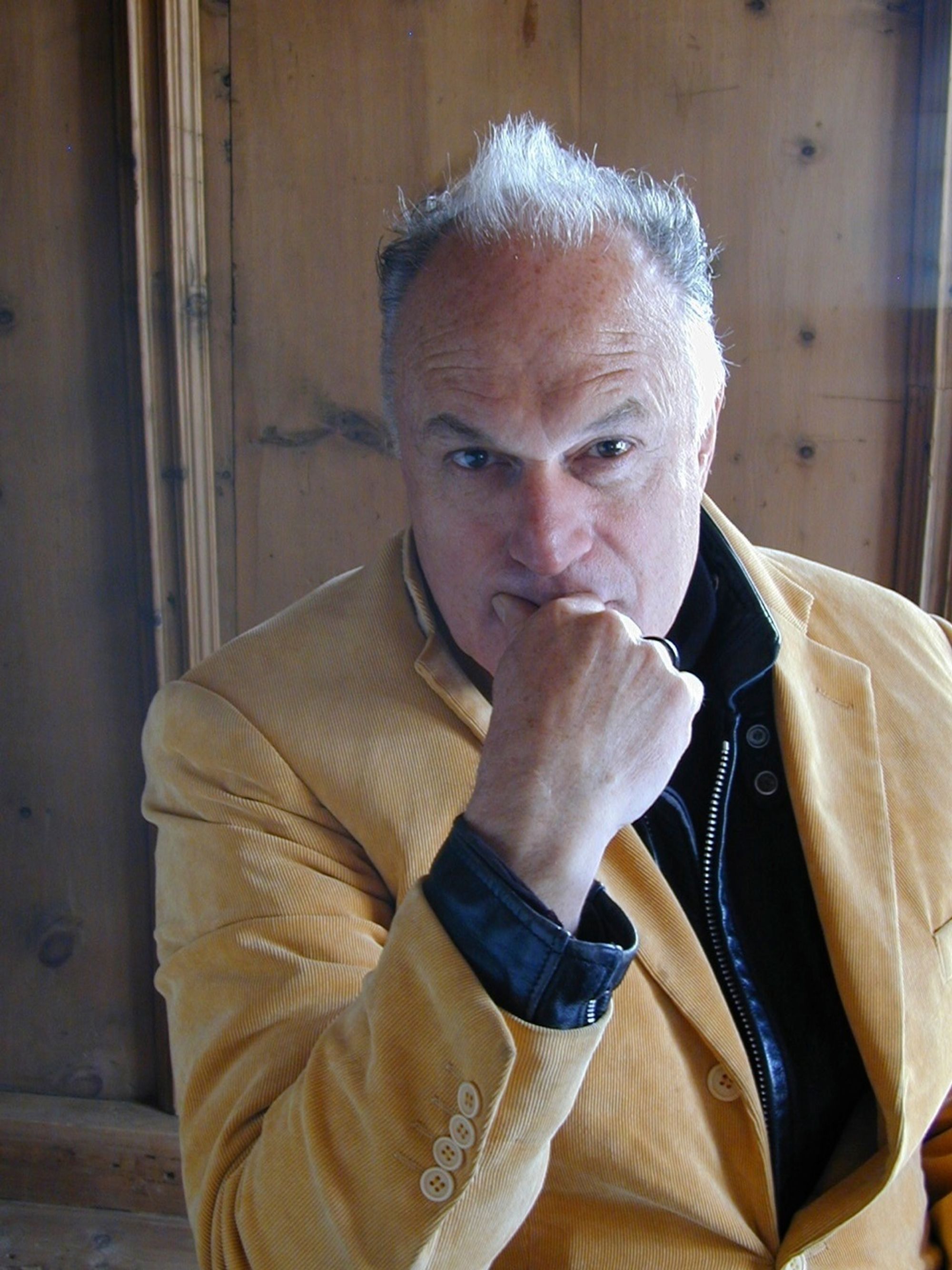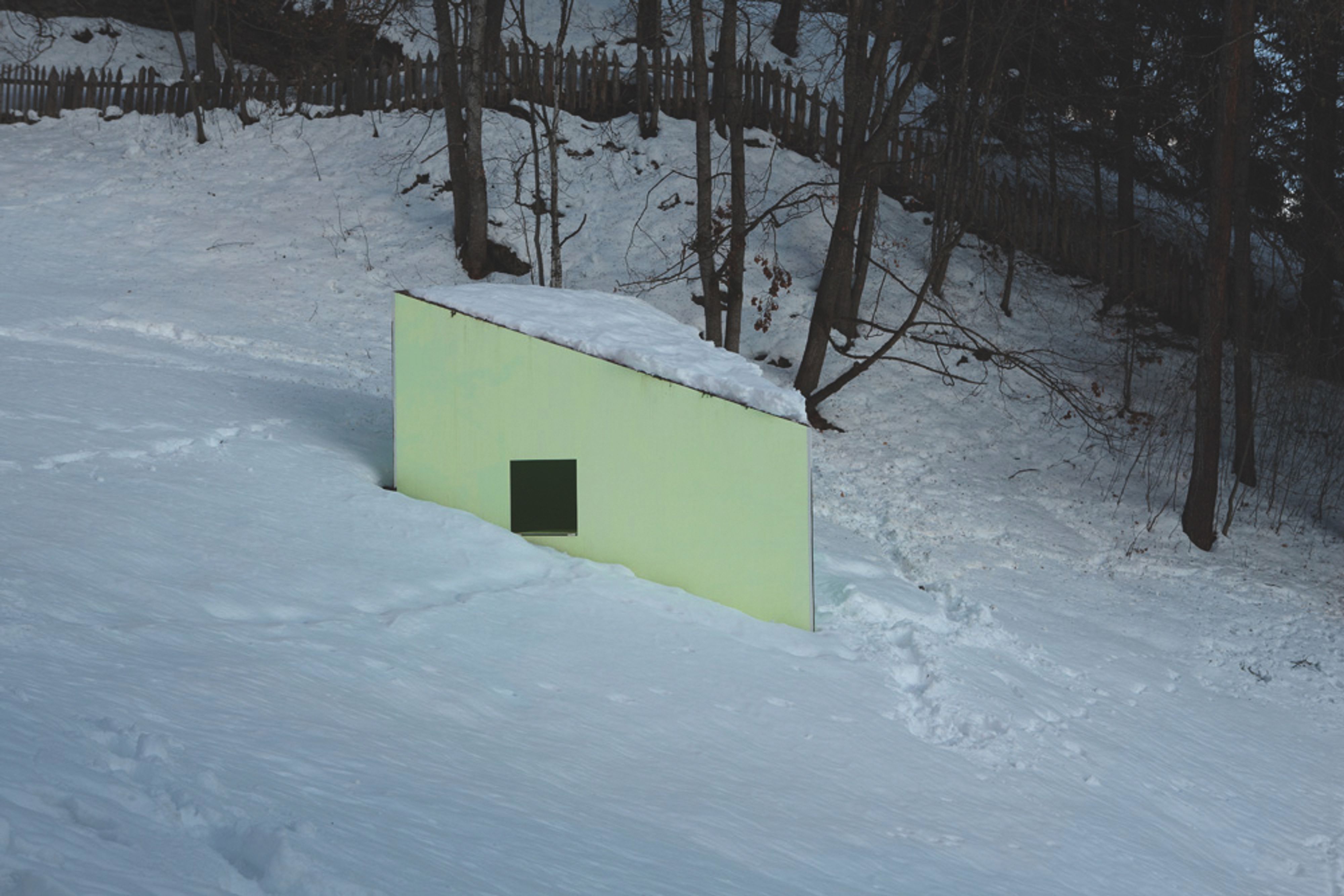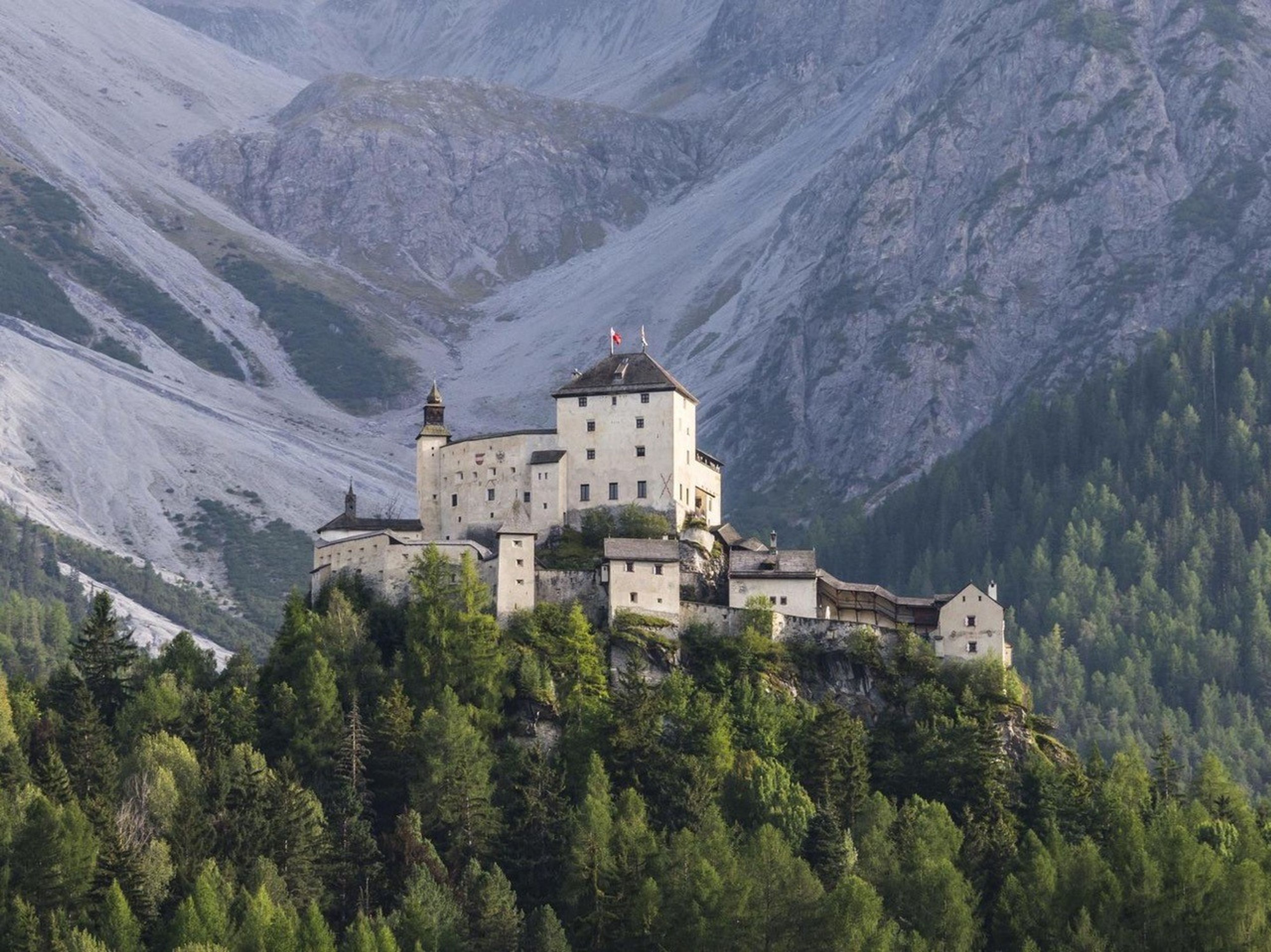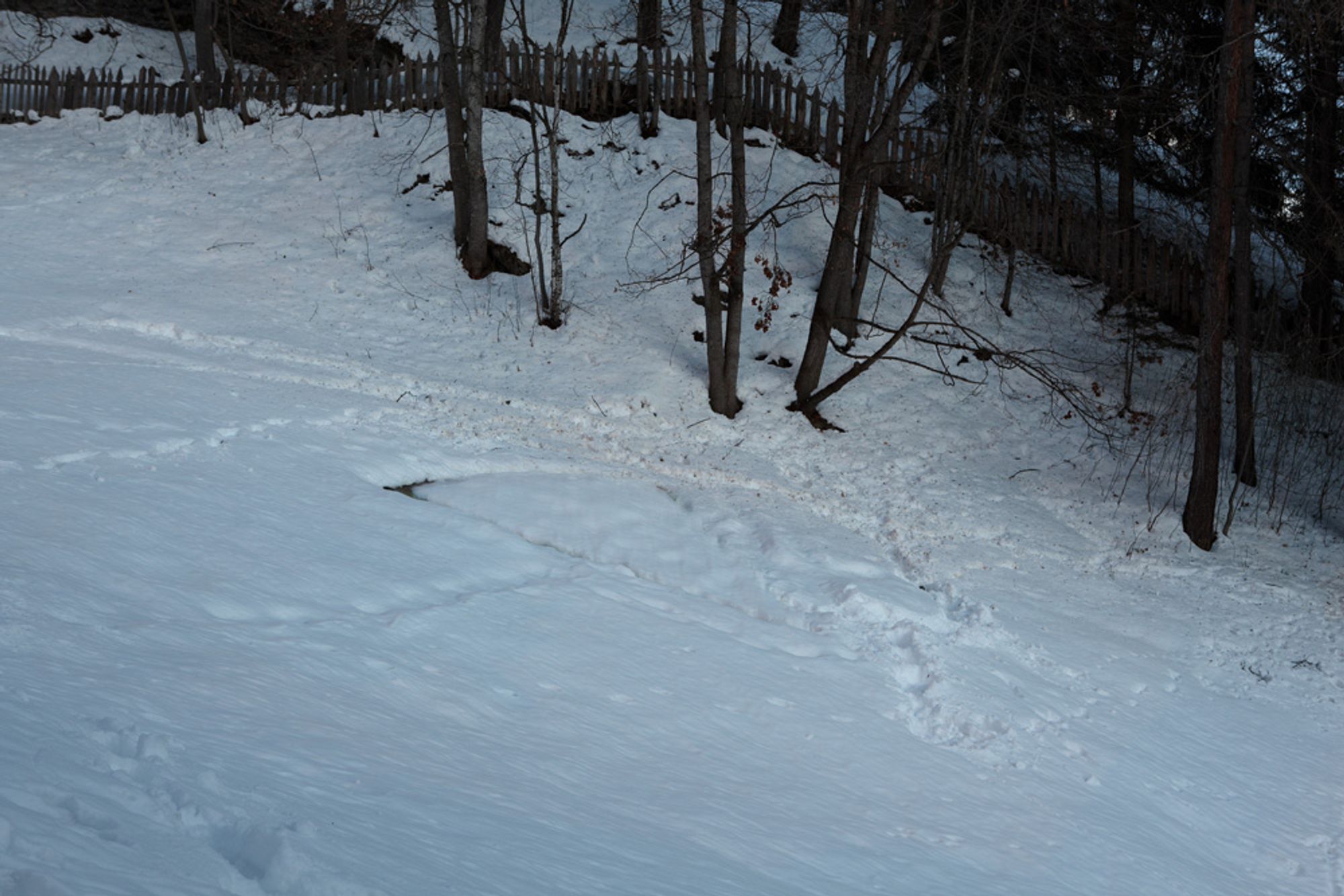
Not Vital. Photo: Beny Steiner.

Not Vital, JOSÜJO (Disappearing House), 2007. fundaziun Not Vital, Parkin, Sent, Switzerland. Photos: Eric Powell.
I am looking at my friend as we sit on a bentwood cafe chair inside of a compact steel prism with a grass-covered roof, sinking beneath a hillside in the Engadin village of Sent. The mechanism that is lowering us into the ground, controlled by “up” and “down” buttons about 1,000 feet away, is loud like a construction site. I can see the grassy top layer slowly subside through one cut-out window until it slips out of site. Once submerged, the noise of the motor stops, and we are bathed in complete silence and darkness, our eyes and ears adjusting to the sensory deprivation. For a minute we keep still, and the interior of the “Josüjo” or “Disappearing House” begins to reveal itself again, enveloping us in a green phosphorescent glow that is growing stronger. It is breathtaking; the green light has rendered the depth between my body and the surfaces around me abstract. As I move, slowly touching the cold metal walls to reestablish a physical understanding of my surroundings, I am struck by the way that surrendering to this structure brings me a deep feeling of calm. I am quite content here, embedded in a verdant slope beneath a planted roof which, having now been dropped into its subterranean place, is seamlessly integrated with the rest of the hillside. We, and this little building, have effectively disappeared.
The rest of the time I spend traversing the Engadin Valley with the artist Not Vital, visiting his sprawling sculpture park, his library of precious Romansch books, his sprayed-concrete painting studio, his childhood home in Sent, and his castle, the Schloss Tarasp, I try in vain to glean what motivated his tremendous outpouring of work. It seems to me that he gathers strength from a tight knot of impatience and extreme determination. The sheer scale of his imprint on this place (and, indeed, all over the world, from the House to Watch the Sunset on the edge of the Amazon to House to Watch 3 Volcanoes on the Indonesian island of Flores to his marble island, NotOna, situated in a vast Patagonian lake) is beyond comprehension until one is here; walking, driving, riding on a boat, climbing endless stairs, opening trap doors, crossing bridges, hiking up mountains. It is staggering to consider his facility for conceptualizing these installations and then actually realizing them. As anyone building anything will know, the devil lies in wresting a physical product from its conception, requiring complex networks of human partnerships. Vital responds to my questions about this — the nitty gritty of his process — with the most oblique answers. “Drawings are not always necessary”; “Everything had to be carried into the valley with a helicopter”; “You don’t have to build something to make something….” He is known to not give too much away. As a visitor, I am invited only to partake in a deliberate exploration of his completed spaces, like an audience at a theater. There is a distinct absence of struggle and labor, as if all these places appeared at the moment he imagined them. I want to understand better what he means when he says, “As I am not an architect, I have freedom.”

Not Vital. Photo: Beny Steiner.

Not Vital, Painting Studio, 2015. Sent, Switzerland. Photo: Eric Powell.

Tarasp Castle, fundaziun Not Vital, Chastè de Tarasp, Switzerland. Photo: Eric Powell.
Walking towards Vital’s painting studio with the extraordinary mountains beyond, my eye catches the glint of a metallic sculpture he has mounted high up on the stucco façade of his childhood home. Vital explains that it is a likeness of Nijinski, modeled on a photograph taken of the great dancer, mid-jump, at a Swiss sanatorium where he spent days in a schizophrenic fog. The moment of this jump, cast in pristine reflective bronze, seems to speak to the explosive beauty of all this artmaking, space-making, excavation, and preservation, but also its precarity. I wonder if it is a kind of memento mori. Vital tells me that Nijinski’s last performance was nearby at the beautiful Suvretta Hotel. I consider the impact of Nijinski’s presence in this valley on Vital — this man known for the way he melded a physical moment and the eternal soul.
We reach his studio in the field behind his house: a rough lumpy mound of concrete that resembles what the inside of a cave might look like if turned inside out. It is monumental in its ugliness, which has been achieved by spraying globs of concrete over a simple core structure. He explains that the studio was conceived as a space to block out the overpoweringly magnificent views around us, and as such there are no windows. A sliver of a doorway is opened for us to enter and a perfect geometric volume is revealed inside. Skylights overhead illuminate a 19th-century marble bath at the far end of the pristinely formed room, to which I immediately gravitate. Vital suggests I turn it on. Water spouts from a hole in the bottom of the basin, as if the tub is a fountain. I ask Vital about my favorite quotation of his from Alma’s Zevi’s book on the artist, but he prefers to show me the paintings rather than elaborate:
“Building has been my favorite occupation ever since I can remember. I must have been two years old when I tried to enter a pillow in order to transform it into a shelter. This happened on the veranda of the house in Sent. One year later, in February, together with my brother Jon, I dug a tunnel under the snow in front of our house. The snow had fallen so high that winter that the fence of the garden had completely disappeared. We were digging in the snow for days. Even though it was dark in there, I could see light coming in from above. A blue-ish, cold light. The sound was damped. It was like being inside the belly of a large animal. My brother was at school in his first year and I could be inside the tunnel alone for most of the day, which I preferred. It was a sensation. The smell was also blue. From time to time I would eat some snow. I would eat my tunnel.”

Not Vital, Bridge, 2008. fundaziun Not Vital, Parkin, Sent, Switzerland. Photo: Eric Powell.
Nearing the end of our walk around his sculpture park, Vital takes us to a polished stainless steel bridge over a gushing stream, which he explains was made offsite and dropped into place with a helicopter. It appears so fresh, like it was situated hours before, but Vital tells us it has been here for several years. The bridge is made from two polished steel sheets, one flat that traverses the stream, and the other upright like a wall, bisecting it at a diagonal. In the middle of the wall there is an opening, like a door, and to walk straight across the bridge a person moves along one face of the wall, through the door, and then along the opposite face of the wall, having switched sides. As Vital leads us over the bridge we see him and then we don’t — he disappears as he passes through the opening behind the reflective wall, as if folded into a Jacob’s Ladder. The steel wall, mirroring the woods around us, camouflages everything behind it. The gesture is powerful but still slight, sharp. Vital reappears on the far bank of the stream and we follow his lead.

Not Vital, JOSÜJO (Disappearing House), 2007. fundaziun Not Vital, Parkin, Sent, Switzerland. Photos: Eric Powell.

Not Vital, JOSÜJO (Disappearing House), 2007. fundaziun Not Vital, Parkin, Sent, Switzerland. Photos: Eric Powell.